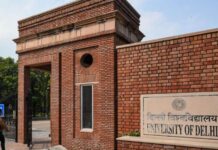Traditional Attire at DU 100th convocation on Feb24 was a lively departure; shift from colonial hats, gowns to colorful diverse attire. This change is recent and part of a broader trend. The transition is a move towards adopting Indian attire for convocations. It reflects reflecting cultural pride. It symbolizes a departure from colonial influences in academic ceremonies. It was during convocation ceremonies. This event blended tradition with cultural vibrancy. This event saw students and teachers along with other staff embracing the change.
Embracing Tradition – A Vibrant Attire Makeover
In a refreshing break from the norm, DU’s recent convocation ceremony took a bold step. All participants, including students and teachers, were guided. They had to wear Indian attire as a mandatory need. This departure injected a unique charm into the ceremony. It celebrates the richness of Indian traditions. As participants adorned themselves in traditional outfits, the event radiated cultural pride.
This shift symbolized more than a change in dress code. It was a celebration of diversity. It was a bold step towards embracing India’s cultural heritage.
Table of Contents
DU’S 100TH ANNUAL CONVOCATION
Colors of Academic Achievement – Diverse Attires for Graduates and Postgraduates
The diversity of attire at the convocation was not only symbolic but also a visual feast. Graduated students distinguished themselves with a variety of colors. They set them apart from their postgraduate counterparts. Ph.D., DM, or MDH holders added a touch of prestige. They strike red-colored handloom fabric stoles embellished with golden borders. These stoles displayed the university’s name and centennial logo.
This departure from standardized attire not only acknowledged academic achievements. But also celebrated individual accomplishments with a burst of colors. It made the convocation a memorable and stunning affair.
A Nod to History – Breaking Down the Gown Tradition
Principal Sanjeev Tiwari of Maharaja Agrasen College shed light on the historical evolution. He gave quite good knowledge of academic attire. The tradition of wearing gowns dates back to 1835, influenced by Lord Macaulay. The recent shift towards Indian dress during convocation ceremonies represents a lot. It was a concerted effort to get rid of colonial history.
This shift signifies a return to the roots of the Indian educational system. It is reminiscent of the Gurukul tradition where students dressed in Indian costumes. This historic reform is a symbolic gesture. It aims to regain cultural identity in academia. And reaffirming the deep-rooted connection between education and culture.
Dhankhar AT JNU Convocation: Nurturing National Pride and Constitutional Values (duupdates.in)
Importance of adoption of traditional attire
The adoption of Traditional Attire at DU holds significant importance. It serves to preserve and promote cultural heritage. Embracing traditional clothing fosters a sense of identity, connecting individuals to their roots. It also plays a crucial role in cultural representation. It allows communities to showcase their unique traditions. Moreover, the adoption of traditional attire can be a means of cultural expression. It fosters pride and a sense of belonging. The significance lies in the preservation of cultural diversity. It fosters a deeper appreciation for traditions. It helps in contributing to a rich tapestry of shared heritage.
Conclusion: A Convocation to Remember – Tradition Meets Colorful Transformation
Delhi University’s 2024 convocation is unforgettable, blending Traditional Attire at DU with a burst of colors. This shift to diverse Indian attires celebrated cultural heritage and academic achievements. This colorful transformation wrote a new chapter in Delhi University’s convocation history. It showcased the institution’s commitment to embracing India’s rich cultural legacy.
FOR MORE UPDATES ON DELHI UNIVERSITY FOLLOW US ON INSTAGRAM.











